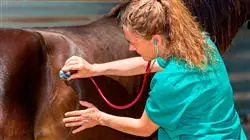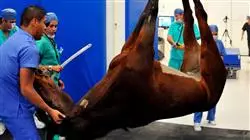University certificate
The world's largest faculty of veterinary medicine”
Introduction to the Program
With this intensive program you will learn how to establish an appropriate methodology for animal cardiopathy examination"

Cardiovascular disorders in animals are highly significant because they can affect their quality of life and life expectancy. Advanced knowledge of cardiology is indispensable for large animal veterinarians: ruminants (cattle, sheep, goats), camelids (alpacas, camels and llamas), swine (pigs, wild boars) and equids (donkeys and mules).
Cardiology in ruminants and swine has been limited, for a long time, due to the limited literature and diagnostic limitations, especially in advanced therapeutic procedures. Regarding Equidae, a high number of horses are used for sporting purposes and cardiac pathologies limit their capacity and even force the animal to withdraw from competition. This is more evident the more demanding the equine is in terms of sport and cardiovascular effort. The management of food species differs, but it also affects their production capacity.
In recent years, there has been a boom in the development of novel diagnostic and therapeutic techniques, such as intracardiac electrocardiograms, electrophysiological mapping in arrhythmias, pacemaker implantation and other intracardiac devices that can be implemented in larger species. These advances, which are necessary for an adequate clinical approach, are not available in books.
Therefore, this Master's Degree offers a comprehensive and developed syllabus that addresses advanced cardiology topics, providing detailed descriptions of the different procedures performed depending on the species, as well as a guide for clinical decision making and patient selection. It incorporates specialized knowledge on cardiology, embryology, anatomy, physiology and cardiac pathophysiology, essential to understand the different pathologies.
These pathologies are covered exhaustively in the syllabus. Not only does it explain what they consist of and how they are treated, but the student also obtains a specialized clinical management guide for each of the cases, which includes decision making, making this Master's Degree a very useful tool for veterinarians.
Cardiac pharmacology plays a relevant role. The key to administering effective treatment lies in the knowledge of the mechanism of action of the different drugs that have an effect on the cardiovascular system, especially when the clinical presentation of cardiac patients is sometimes so different and requires personalized medication.
This unit guides students towards a simple understanding of the action and adverse effects of drugs, which subsequently facilitates an intuitive clinical application.
The Master's Degree in Cardiology in Large Animals brings together all the detailed information on the different fields of Cardiology at a high and advanced level of specialization, and is taught by renowned professors in the field of internal medicine, Cardiology and minimally invasive surgery in veterinary medicine.
A unique, key and decisive training experience to boost your professional development"
This Master's Degree in Veterinary Cardiology in Large Animals contains the most complete and up-to-date educational program on the market. The most important features of the program include:
- Development of practical cases presented by experts in Veterinary Cardiology in Large Animals
- The graphic, schematic, and practical contents with which they are created, provide scientific and practical information on the disciplines that are essential for professional practice
- Latest developments in Veterinary Cardiology in Large Animals
- Practical exercises where self-assessment can be used to improve learning
- Special emphasis on innovative methodologies in Veterinary Cardiology in Large Animals
- Theoretical lessons, questions to the expert, debate forums on controversial topics, and individual reflection assignments
- Content that is accessible from any fixed or portable device with an Internet connection
With this program you will learn how to develop a suitable work methodology to optimize the use of non-invasive diagnostic tests"
The multimedia content, developed with the latest educational technology, will provide the professional with situated and contextual learning, i.e., a simulated environment that will provide immersive learning programmed to train in real situations.
This program is designed around Problem Based Learning, whereby the specialist must try to solve the different professional practice situations that arise during the academic year. For this purpose, the professional will be assisted by an innovative interactive video system created by renowned and experienced experts in Veterinary Cardiology in Large Animals.
This program has the best teaching material on the market, which will allow you to study in context, quickly and efficiently"

Combine your studies with your professional work while you increase your knowledge in veterinary cardiology"
Why study at TECH?
TECH is the world’s largest online university. With an impressive catalog of more than 14,000 university programs available in 11 languages, it is positioned as a leader in employability, with a 99% job placement rate. In addition, it relies on an enormous faculty of more than 6,000 professors of the highest international renown.

Study at the world's largest online university and guarantee your professional success. The future starts at TECH”
The world’s best online university according to FORBES
The prestigious Forbes magazine, specialized in business and finance, has highlighted TECH as “the world's best online university” This is what they have recently stated in an article in their digital edition in which they echo the success story of this institution, “thanks to the academic offer it provides, the selection of its teaching staff, and an innovative learning method aimed at educating the professionals of the future”
A revolutionary study method, a cutting-edge faculty and a practical focus: the key to TECH's success.
The most complete study plans on the university scene
TECH offers the most complete study plans on the university scene, with syllabuses that cover fundamental concepts and, at the same time, the main scientific advances in their specific scientific areas. In addition, these programs are continuously being updated to guarantee students the academic vanguard and the most in-demand professional skills. In this way, the university's qualifications provide its graduates with a significant advantage to propel their careers to success.
TECH offers the most comprehensive and intensive study plans on the current university scene.
A world-class teaching staff
TECH's teaching staff is made up of more than 6,000 professors with the highest international recognition. Professors, researchers and top executives of multinational companies, including Isaiah Covington, performance coach of the Boston Celtics; Magda Romanska, principal investigator at Harvard MetaLAB; Ignacio Wistumba, chairman of the department of translational molecular pathology at MD Anderson Cancer Center; and D.W. Pine, creative director of TIME magazine, among others.
Internationally renowned experts, specialized in different branches of Health, Technology, Communication and Business, form part of the TECH faculty.
A unique learning method
TECH is the first university to use Relearning in all its programs. It is the best online learning methodology, accredited with international teaching quality certifications, provided by prestigious educational agencies. In addition, this disruptive educational model is complemented with the “Case Method”, thereby setting up a unique online teaching strategy. Innovative teaching resources are also implemented, including detailed videos, infographics and interactive summaries.
TECH combines Relearning and the Case Method in all its university programs to guarantee excellent theoretical and practical learning, studying whenever and wherever you want.
The world's largest online university
TECH is the world’s largest online university. We are the largest educational institution, with the best and widest online educational catalog, one hundred percent online and covering the vast majority of areas of knowledge. We offer a large selection of our own degrees and accredited online undergraduate and postgraduate degrees. In total, more than 14,000 university degrees, in eleven different languages, make us the largest educational largest in the world.
TECH has the world's most extensive catalog of academic and official programs, available in more than 11 languages.
Google Premier Partner
The American technology giant has awarded TECH the Google Google Premier Partner badge. This award, which is only available to 3% of the world's companies, highlights the efficient, flexible and tailored experience that this university provides to students. The recognition as a Google Premier Partner not only accredits the maximum rigor, performance and investment in TECH's digital infrastructures, but also places this university as one of the world's leading technology companies.
Google has positioned TECH in the top 3% of the world's most important technology companies by awarding it its Google Premier Partner badge.
The official online university of the NBA
TECH is the official online university of the NBA. Thanks to our agreement with the biggest league in basketball, we offer our students exclusive university programs, as well as a wide variety of educational resources focused on the business of the league and other areas of the sports industry. Each program is made up of a uniquely designed syllabus and features exceptional guest hosts: professionals with a distinguished sports background who will offer their expertise on the most relevant topics.
TECH has been selected by the NBA, the world's top basketball league, as its official online university.
The top-rated university by its students
Students have positioned TECH as the world's top-rated university on the main review websites, with a highest rating of 4.9 out of 5, obtained from more than 1,000 reviews. These results consolidate TECH as the benchmark university institution at an international level, reflecting the excellence and positive impact of its educational model.” reflecting the excellence and positive impact of its educational model.”
TECH is the world’s top-rated university by its students.
Leaders in employability
TECH has managed to become the leading university in employability. 99% of its students obtain jobs in the academic field they have studied, within one year of completing any of the university's programs. A similar number achieve immediate career enhancement. All this thanks to a study methodology that bases its effectiveness on the acquisition of practical skills, which are absolutely necessary for professional development.
99% of TECH graduates find a job within a year of completing their studies.
Master’s Degree in Veterinary Cardiology in Large Animals
The diagnosis and prescription for the appropriate management of cardiac pathologies affecting ruminants, camelids, swine, and equids require a solid set of competencies in medical intervention. At TECH Global University, one of our primary objectives is to support the specialization processes of professionals, which is why we have created this program focused on the thorough study of the etiology and progression of vascular system diseases (endocardium, myocardium, pericardium) in the organisms of various species in this category. Over the course of the one-year curriculum, the program will first revisit the embryology, anatomy, and physiology of these animals, and later delve into general exploration, non-invasive complementary tests, arrhythmia management, pharmacology, and advanced cardiac procedures such as minimally invasive surgery and cardiopulmonary resuscitation. This theoretical-practical journey will equip students with the ability to properly identify symptoms and plan the respective treatments.
Study the Master's Degree in Veterinary Cardiology
This postgraduate program from TECH offers a significant opportunity to reach a high level of expertise in daily clinical practice, as it not only strengthens the skills necessary to perform interventions but also enriches knowledge for making differential diagnoses and establishing therapeutic protocols. Additionally, through our case analysis methodology and problem-based learning approach, students will confront real medical cases, where they will need to mobilize the available resources to address each situation appropriately. With the knowledge gained, professionals will be able to activate a series of action mechanisms, essential for the rapid stabilization of patients, starting with the early detection of pathological signs. All of this will also enable them to design and adopt their own working methodologies aimed at promoting comprehensive assessment. As a result, graduates of this program will be recognized for their outstanding performance, reducing risk factors that affect the quality and life expectancy of the animals.







